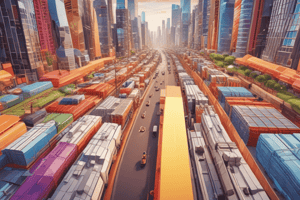Podcast
Questions and Answers
Which of the following is NOT a typical concern for foreign companies doing international business?
Which of the following is NOT a typical concern for foreign companies doing international business?
- Fluctuating exchange rates
- Cultural differences
- Political instability
- Guaranteed high profits (correct)
Canada is primarily an exporting nation, meaning it sends more goods and services to other countries than it receives.
Canada is primarily an exporting nation, meaning it sends more goods and services to other countries than it receives.
False (B)
Name three products that are among Canada's top exports.
Name three products that are among Canada's top exports.
oil, vehicles, and machinery
A ______ dollar is generally good for exporters because their goods become cheaper for foreign buyers.
A ______ dollar is generally good for exporters because their goods become cheaper for foreign buyers.
Match the following terms with their descriptions:
Match the following terms with their descriptions:
Which of the following best describes crude oil?
Which of the following best describes crude oil?
The TransMountain pipeline currently transports the majority of Canada's oil exports.
The TransMountain pipeline currently transports the majority of Canada's oil exports.
Besides fuel, what are two other uses for oil?
Besides fuel, what are two other uses for oil?
Which of the following best defines 'geopolitical'?
Which of the following best defines 'geopolitical'?
China is currently considered a democratic country.
China is currently considered a democratic country.
What is the concept of opportunity cost?
What is the concept of opportunity cost?
NAFTA gives all 3 countries access to each other's _________.
NAFTA gives all 3 countries access to each other's _________.
Match the following trade agreements with their acronyms:
Match the following trade agreements with their acronyms:
What is the primary goal behind the formation of NAFTA, now USMCA or CUSMA?
What is the primary goal behind the formation of NAFTA, now USMCA or CUSMA?
A decrease in corporate taxes in the US would likely help Canada economically.
A decrease in corporate taxes in the US would likely help Canada economically.
If the value of our dollar decreases, can we import more or less cheaply?
If the value of our dollar decreases, can we import more or less cheaply?
According to the content, what is a significant threat resulting from potential tariffs on Canadian exports?
According to the content, what is a significant threat resulting from potential tariffs on Canadian exports?
The European Union is primarily a fiscal union.
The European Union is primarily a fiscal union.
What does the acronym WTO stand for?
What does the acronym WTO stand for?
Due to Brexit, importing from the EU is much more ______ which has harmed the _______ sector.
Due to Brexit, importing from the EU is much more ______ which has harmed the _______ sector.
Match the descriptions with the correct term:
Match the descriptions with the correct term:
What is a common consequence of the labor market in former industrial powerhouses?
What is a common consequence of the labor market in former industrial powerhouses?
The content indicates that the goal is for monetary policy and fiscal policy to operate separately.
The content indicates that the goal is for monetary policy and fiscal policy to operate separately.
What was a key problem in Greece in 2008?
What was a key problem in Greece in 2008?
What is a tariff?
What is a tariff?
All countries are part of the WTO.
All countries are part of the WTO.
What primary sector are low-income countries looking to trade in?
What primary sector are low-income countries looking to trade in?
The WTO implements _______ to protect Canada's _____________ from stronger countries like __________________.
The WTO implements _______ to protect Canada's _____________ from stronger countries like __________________.
Match the following trade terms with their definitions:
Match the following trade terms with their definitions:
What is the purpose of a trade embargo?
What is the purpose of a trade embargo?
Supply management leads to higher prices for consumers in Canada.
Supply management leads to higher prices for consumers in Canada.
Why is supply management considered a barrier to trade?
Why is supply management considered a barrier to trade?
Which provinces have a significant number of dairy, egg, and poultry farmers?
Which provinces have a significant number of dairy, egg, and poultry farmers?
Consumers are indifferent to the prices of dairy goods due to supply management.
Consumers are indifferent to the prices of dairy goods due to supply management.
What is OPEC?
What is OPEC?
The USA is now an energy __________.
The USA is now an energy __________.
Why do Canada and other nations sanction countries?
Why do Canada and other nations sanction countries?
What impacts did the trade embargo have?
What impacts did the trade embargo have?
Sanctions on other countries are often effective in changing government behavior.
Sanctions on other countries are often effective in changing government behavior.
Which of the following factors can cause the value of a dollar to drop?
Which of the following factors can cause the value of a dollar to drop?
A floating dollar is not influenced by the market forces of supply and demand.
A floating dollar is not influenced by the market forces of supply and demand.
What is BYD known for manufacturing?
What is BYD known for manufacturing?
Traditionally, our dollar value has been pegged to the price of ____________.
Traditionally, our dollar value has been pegged to the price of ____________.
Match the following terms related to lumber with their descriptions:
Match the following terms related to lumber with their descriptions:
What is the primary consequence of applying tariffs on softwood lumber?
What is the primary consequence of applying tariffs on softwood lumber?
All countries have the same tariff rates for softwood lumber.
All countries have the same tariff rates for softwood lumber.
In what area does Maersk primarily operate?
In what area does Maersk primarily operate?
Flashcards
Trade Deficit
Trade Deficit
A situation where a country imports more goods and services than it exports, resulting in a negative balance of trade.
Trade Surplus
Trade Surplus
A situation where a country exports more goods and services than it imports, resulting in a positive balance of trade.
Depreciating Dollar
Depreciating Dollar
The value of a country's currency decreasing against other currencies.
Appreciating Dollar
Appreciating Dollar
Signup and view all the flashcards
Exporting
Exporting
Signup and view all the flashcards
Importing
Importing
Signup and view all the flashcards
Comparative Advantage
Comparative Advantage
Signup and view all the flashcards
Factors Affecting Imports
Factors Affecting Imports
Signup and view all the flashcards
Rule of Law
Rule of Law
Signup and view all the flashcards
WTO (World Trade Organization)
WTO (World Trade Organization)
Signup and view all the flashcards
Monetary Policy
Monetary Policy
Signup and view all the flashcards
Fiscal Policy
Fiscal Policy
Signup and view all the flashcards
Monetary Union
Monetary Union
Signup and view all the flashcards
Fiscal Union
Fiscal Union
Signup and view all the flashcards
Digital Service Tax
Digital Service Tax
Signup and view all the flashcards
Targeted Tariff on a State
Targeted Tariff on a State
Signup and view all the flashcards
Trade Deficit/Surplus
Trade Deficit/Surplus
Signup and view all the flashcards
Global Headline Inflation
Global Headline Inflation
Signup and view all the flashcards
Subsidies
Subsidies
Signup and view all the flashcards
Opportunity Cost
Opportunity Cost
Signup and view all the flashcards
Economic Turmoil
Economic Turmoil
Signup and view all the flashcards
Multiplier Effect
Multiplier Effect
Signup and view all the flashcards
Blocs
Blocs
Signup and view all the flashcards
Globalization
Globalization
Signup and view all the flashcards
Trade Quota
Trade Quota
Signup and view all the flashcards
Trade Embargo
Trade Embargo
Signup and view all the flashcards
Non-Tariff Barriers
Non-Tariff Barriers
Signup and view all the flashcards
Supply Management
Supply Management
Signup and view all the flashcards
Tariff
Tariff
Signup and view all the flashcards
Currency Exchange
Currency Exchange
Signup and view all the flashcards
Sanction
Sanction
Signup and view all the flashcards
Trade Barriers
Trade Barriers
Signup and view all the flashcards
Depreciating Currency
Depreciating Currency
Signup and view all the flashcards
Appreciating Currency
Appreciating Currency
Signup and view all the flashcards
Carbon Adjustment Tax
Carbon Adjustment Tax
Signup and view all the flashcards
OPEC (Organization of the Petroleum Exporting Countries)
OPEC (Organization of the Petroleum Exporting Countries)
Signup and view all the flashcards
Trade Sanction
Trade Sanction
Signup and view all the flashcards
Dollar Value
Dollar Value
Signup and view all the flashcards
Floating Dollar
Floating Dollar
Signup and view all the flashcards
Fixed Dollar
Fixed Dollar
Signup and view all the flashcards
Stumpage Fees
Stumpage Fees
Signup and view all the flashcards
Supply Chain
Supply Chain
Signup and view all the flashcards
Transportation
Transportation
Signup and view all the flashcards
Plus One Strategy
Plus One Strategy
Signup and view all the flashcards
Study Notes
Unit 1: International Business
- Has international business made Canadians wealthier?
- International business looks like exporting and importing goods.
- Five benefits to international business: greater access to goods, lower costs, increased competition, economic growth, and specialization.
- Five downsides to international business: job losses in domestic industries, exploitation of workers, environmental damage, trade imbalances, and dependency.
- Five concerns for foreign companies: high competition, government regulations, currency fluctuations, differing business practices, and political instability.
- Walmart maintains low prices through efficient supply chains.
- Canada is an important exporter of goods, particularly resources and food.
- Importing means bringing in goods from other countries.
- Exporting means sending goods to other countries for sale.
Unit 1: Canadian Exports
- Top three Canadian exports: focus on natural resources, including crude oil and agricultural products.
- Countries import/export raw materials and finished goods for domestic consumption or to other countries.
- Oil export is a significant part of Canada's GDP.
- Oil is used for fuel, manufacturing, and electricity generation.
- Five Canadian provinces refine oil: Alberta, Saskatchewan, Manitoba, Ontario, and New Brunswick.
- Oil pipelines end in the US or elsewhere.
- Economic benefits of oil: employment, revenue for the government, economic activity and investment.
- Economic downsides of oil: environmental concerns, reliance on the global market, volatility of prices.
- Top oil consumers in the world: the US, China, India.
- Canada ranks highly in producing oil.
- Canadian oil comes from crude oil extraction and tar sands.
- Refining tar sands oil is more expensive.
- Canadian production of oil increases with higher prices.
- Canada's reliance on oil production needs consideration.
Unit 1: Oil Pipelines and Canada's Economy
- BPD stands for barrels per day.
- Global oil production: estimates for world daily production in barrels.
- Canada's oil exports in barrels per day.
- TransMountain pipeline history: a timeline of the pipeline's development.
- TransMountain pipeline capacity in barrels.
- Potential sellers to the TransMountain pipeline: details about potential buyers.
- Government spending on the pipeline: details on amounts spent.
- Canadian imports.
- Criticality of imports vs. exports.
- Countries known for trade surpluses and deficits.
- Canada's trade balance: states whether a trade deficit or surplus exists.
Unit 2: Factors Influencing International Trade
- Factors influencing a country's ability to import: fluctuations in exchange rates, tariffs and trade restrictions, and availability of goods and services.
- Canadian imports: types of goods and services imported.
- Exchange rates affect importing/exporting costs.
- Factors influencing currency value: geopolitical factors, market sentiment, interest rates, economic growth, risk aversion, and inflation.
- Impact of China's economic policies on international trade.
Unit 2: Temporary Foreign Workers (TFWs)
- TFWs come to Canada for temporary work.
- Five sectors that employ TFWs.
- Sizes of companies that recruit TFWs.
- Upsides of recruiting TFWs. The role of TFWs in Canadian economy.
- Downsides of using TFWs: effects on the local labor market, supply and demand issues in various sectors.
- Import concentration issues: focus on questions regarding trade, supply, and demand.
Unit 2: Canada's Trade Partners and Economy
- Canada's largest trade partner.
- Percentage of exports going to that partner.
- Types of goods Canada exports to its largest trade partner.
- Importance of stability in trading partner countries.
Unit 3: China's Role in the Global Economy
- China's role as a top global economy: aspects that contribute to this standing.
- The nature of China's economic system: Is it a democracy?
- Basis of China's economy: focus on its foundational economic sectors.
- China's wage policies and their effect on businesses.
- Inflation concerns in Canada.
- Economic sector shift in China.
- Impact of a potential Chinese recession vs. a US recession.
Unit 4: Trade Agreements and Policies
- NAFTA, USMCA, and CUSMA definitions and differences.
- Countries involved in each agreement.
- Discussion of NAFTA's impact.
- Trump's actions toward NAFTA: goals, actions, and their impact.
Unit 5: Trade Barriers and International Trade
- Definition of a trade sanction.
- Purpose of a trade sanction.
- Examples of countries subject to trade sanctions by Canada.
- Trade embargo examples and impact on trading countries.
- Trade quota examples.
- Supply management definitions and impacts.
- Benefits and drawbacks of supply management.
- Discussion of the issues with supply management.
- Impact of sanctions on consumers and businesses.
- Economic disruption from embargos.
Unit 5: International Trade Agreements (cont.)
- WTO definition and roles played.
- WTO creation date and problems that need to be solved.
- Canada's dependence on the WTO.
- Dispute mechanisms and examples.
Unit 6: Supply Chains, Logistics, and Transportation
- Definition of supply chain.
- Factors affecting supply chains.
- Overview of the world's largest shipping company.
- Critical logistical routes and transportation methods impacting goods traffic: analysis of bridges and highways as a key infrastructure.
- Economic aspects of specific supply chains.
Studying That Suits You
Use AI to generate personalized quizzes and flashcards to suit your learning preferences.
Related Documents
Description
Explore the fundamentals of international business and its impact on the Canadian economy. This quiz covers topics such as the benefits and downsides of international trade, concerns for foreign companies, and Canada's role in exporting goods. Test your understanding of how international business shapes wealth and competition in Canada.





